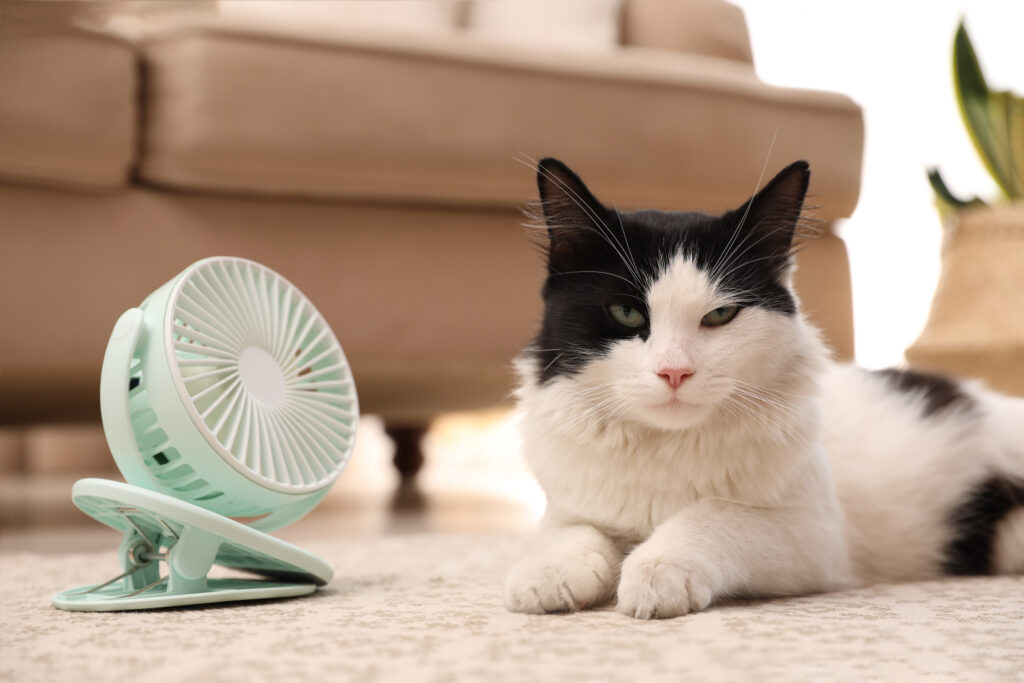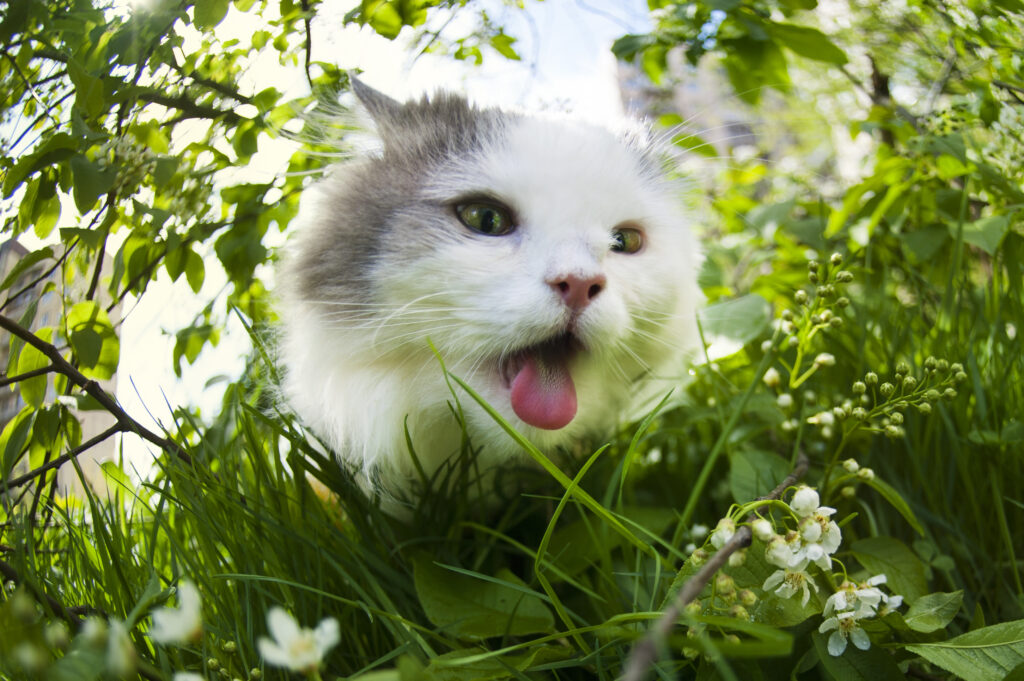Key points
- Looking forward to summer fun with your panting pup or adventurous cat? There’s a few things you should know first.
- Beach days with your pet might be cute, but remember that your furry friend can’t tell you when they’re overheating.
- It’s your job to look out for signs of dehydration and heatstroke in your pet, provide them with plenty of fresh water, and create shady spots for them to beat the heat.
Summer’s here, and while we humans might be reaching for the sunscreen and firing up the grill, our furry companions can struggle with the heat.
Fun fact: both dogs and cats have a higher average body temperature than humans, and have evolved to handle the heat in their own unique ways, like panting and self-grooming. That said, they still need extra help to stay cool and comfortable through the summer.
Human conveniences like AC and ice cubes can go a long way — if you can tell when your pet is too hot. We’re here to debunk five common myths about pets and heat that, contrary to popular belief, could end up causing more harm than help to your dog or cat’s health. Plus, we’ll share some tips and treats to help your fur family enjoy the summer weather.
Myth #1: My Dog or Cat Will Be Fine Inside – They Don’t Need AC

Wrong! While cats and dogs have evolved some strategies to keep cool, they’re not above a bit of help from their favorite humans. Both dogs and cats can get too hot in the summer, and heatstroke can happen anywhere.
Dogs have a higher risk of heatstroke due to their active lifestyles and time spent outdoors, but that doesn’t mean your pet can’t overheat inside a hot apartment. Your dog or cat appreciates a cool breeze from the AC as much as you do — keep this in mind if your fur kid spends long periods of time lounging indoors.
As you may know, dogs and cats don’t have the same built-in cooling mechanisms as humans. While they can sweat through their paws and pant to cool down, they may need extra help to regulate their body temperature on very hot days. Dogs and cats tend to run warmer than their human counterparts, so it’s normal for their temperatures to reach 102 degrees Fahrenheit, Dr. Patricia Collins, DVM, told Pumpkin. If they exceed that temperature or show signs of overheating, it is important to take steps to cool your pet down.
How do I check my pet’s temperature?
There are human thermometers that can be used for pets, but at our hospital, we have digital pet-specific thermometers that work great. Many online retailers now carry digital pet thermometers too, so you can order one to keep on hand during the summer months.
— Dr. Mondrian Contreras, DVM
“Signs of overheating in dogs include excessive panting, dark red gums, vomiting, drooling, fast heart rate, and high temperature,” Dr. Collins explained. Subtler symptoms — like weakness, lack of energy, or diarrhea — can have multiple causes, but may also signal that your dog is too hot.
If your dog displays any of these signs, don’t hesitate to call your vet. Heat-related illness can come on quickly, so acting fast and seeking medical care for your pet is key. Additionally, we recommend getting pet insurance for your dog before the first heat wave hits this summer (if you haven’t already). This way, if your pup gets sick unexpectedly, you can help them get the best care possible, knowing you have coverage even if treatment is costly. Pet insurance providers like Pumpkin offer up to 90% cash back on all eligible vet bills, so pet owners can make the best decisions for their pets’ health with less financial stress.
Try these tips to keep your canine cool this summer:
Finally, if your pet has underlying health conditions, they may be at a higher risk for heatstroke. For instance, brachycephalic breeds like pugs and bulldogs are prone to breathing issues, which in turn can make it difficult for them to regulate their temperature through panting. Elderly, overweight, and dark-coated dogs also have a greater chance of overheating.
Myth #2: My Dog Needs a Summer Haircut to Stay Cool

While the idea of wearing multiple layers at the peak of summer might sound miserable to you, your pet’s coat actually helps them weather the heat! You can think of your dog’s fur or hair as insulation: it keeps them from getting too cold in the winter, but it also prevents overheating in the summer.
“The haircoat works like a Thermos bottle in that it keeps the desired body temperature longer than if their bare skin is exposed to heat or direct sun,” Dr. Collins said.Dogs with thick coats naturally shed, so they have lighter coats in the summer. Some dog breeds, such as Huskies and Malamutes, maintain thick double coats that help them withstand extreme temperatures. Shaving or even trimming these dogs is never a good idea, as it would interfere with their natural cooling system.
What about double-coated breeds?
Double-coated breeds have two layers of fur: a dense, soft undercoat for insulation and a coarser outcoat for protection. These breeds are well-adapted for various weather conditions and thus have an undercoat to help insulate them in cold weather and an outer coat that helps repel water and insulate against heat.
— Dr. Mondrian Contreras, DVM
Long-coated dogs like poodles, schnauzers, shih-tzus, sheepdogs, and others require regular grooming to keep their coats manageable, and summertime is no exception. That being said, these haircuts are necessary to avoid matting, not overheating.
Never shave your dog down to the skin, and avoid home haircuts with scissors if your dog has a tricky coat. If you’re unsure of your pet’s grooming needs, it is best to take them to a professional.
And don’t forget to groom your cats, too. Cats are notorious self-groomers, but they appreciate some help with their primping and preening. Brushing your cat will help them shed excess hair, which traps heat in. Plus, better to go right to the source rather than lint-rolling the couch later.
Myth #3: Dogs Don’t Sweat, So They Can’t Get Dehydrated

While it’s true that dogs sweat less than humans, they do sweat — primarily from their paw pads. However, this isn’t enough to keep them cool on a hot day. Dog panting is a sign your pup is trying to cool down, but it also leads to dehydration. You might be surprised to learn that cats do the same thing when they’re dehydrated or hot.
Both dogs and cats can become dehydrated more quickly in the summertime, especially if they are exercising in very hot or humid weather. Do not leave your pet in a hot car, even for a little while: the temperature can increase rapidly and put your dog or cat at risk.
How much water does my pet really need?
As a general rule, dogs should drink approximately 1 ounce of water per pound of body weight each day. Cats typically require around 3.5–4.5 ounces of water per 5 pounds of body weight per day.
— Dr. Mondrian Contreras, DVM
It’s important to recognize the signs of dehydration in your pet before it becomes an emergency. Dehydration can lead to loss of appetite, which only makes things worse, as your pet’s wet food is full of vital fluids and electrolytes. Dehydration also puts your dog or cat at risk for heatstroke, which can be deadly.
Keep an eye out for panting and sweaty paws to know when your pet needs extra water. Be sure to look out for these signs of more severe dehydration in your dog, too:
- Lethargy or lack of energy
- Dry gums and nose
- Sunken eyes
- Panting excessively
- Loss of appetite
- Thick, sticky saliva
To avoid risking dehydration on hot summer days, you and your dog should both have plenty of fresh, cool water available. Carry water and a portable bowl on walks, as communal water bowls at restaurants and dog parks could put your pup at risk of kennel cough. You can also add ice cubes or a bit of low-sodium broth to their water bowl at home for some extra encouragement.
Myth #4: These Paws Were Made for Walking on Hot Pavement

Ever walked barefoot on scorching asphalt? Not fun, right? Well, it’s just as uncomfortable (and potentially dangerous) for your dog. Paw pads can tolerate some heat, but they’re susceptible to burns just like our skin.
Keep in mind that the ground is usually hotter than the air, and the material of pavement matters. Take a sunny, 85-degree day for example. Asphalt will reach a surface temperature of over 140 degrees in the sun, which is hot enough to burn your dog’s paw pads, according to Sussex County Animal Hospital. Brick and concrete won’t get quite as hot, but can still cause your pet discomfort.
How hot is too hot to walk my dog?
If the air temperature is above 90 degrees Fahrenheit, pavement should be avoided as it could be significantly hotter and cause burns and severe discomfort to the dog’s paws.
— Dr. Mondrian Contreras, DVM
To keep your dog’s paws safe this summer, try the “touch test.” Touch the pavement or surface where you plan to walk with the back of your hand, and if it’s too hot for you to keep it there for five seconds, it’s definitely too hot for your dog’s paw pads.
“Temperatures around 70 degrees Fahrenheit are best for walking your dog,” Dr. Collins advised. Try walking early in the morning or later in the evening after the sun has set. The pavement should be cool enough for your dog to safely walk at these times.
If your dog needs to go out in peak heat, guide them to grassy or shaded areas where the pavement is a bit cooler. You can also try paw protection wax or balms, or booties if your dog tolerates them.
Myth #5: My Cat Isn’t Panting, So They Must Not Be Hot

Cats are masters of disguise, and sometimes their cool demeanor can mask discomfort. While panting isn’t as common in cats as it is in dogs, it does help them cool off when they’re too hot.
Panting animals inhale cooler, drier air and expel warm, moist air (along with some drool) to rid themselves of excess body heat. They lose some water in the process, but the result is generally a cooler cat or canine.
With that said, cat panting can also be a sign of stress or illness, so it’s important to consider the context and look out for other signs that your cat is overheating. If your cat is panting during a car ride to the vet, for instance, they may be anxious but otherwise fine.
If your cat’s panting is accompanied by any of the following symptoms, contact your vet immediately:
- Bright, glazed eyes
- Rapid breathing
- Lethargy
- Drooling
- Excessive grooming
Your cat may groom themselves more often than usual when it’s hot out, as that helps them remove excess hair and cools them off as their saliva evaporates. It’s hard to say how much grooming is really “excessive” for an individual cat, so consult your vet if you aren’t sure.
You can do your part in keeping your cat cool by ensuring that they have access to fresh, cool water at all times. Some cats will avoid standing or still water where dust particles, hair, and germs can land, so either change your cat’s water often or consider a cat water fountain.
Some other strategies for keeping your cat comfortable throughout the summer include:
- Shady Spots: Cats are all about napping in sunbeams, but provide plenty of cool, shaded areas for them to retreat to indoors and outdoors.
- Cool Surfaces: Place a damp towel on a cool surface where your cat can lie down.
- Brush It Out: Regular brushing can help remove excess fur, especially for breeds prone to shedding. This can help them feel cooler and prevent matting, which can trap heat.
TL;DR: Remember These Summer Pet Safety Tips
If you ever see any of the warning signs of overheating or dehydration outlined in this article, don’t wait — consult your veterinarian right away so you can get your pet the care they need, when they need it.
By understanding these common myths, the actual facts, and taking some simple precautions, you can help ensure your dog or cat stays cool and comfortable all summer long.




